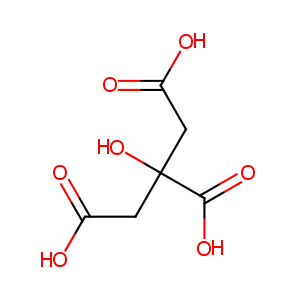Details of the Drug
General Information of Drug (ID: DM80YI7)
| Drug Name |
citric acid
|
||||||||||||||||||||||
|---|---|---|---|---|---|---|---|---|---|---|---|---|---|---|---|---|---|---|---|---|---|---|---|
| Synonyms |
Citric acid; 77-92-9; Citric acid, anhydrous; citrate; Citro; Anhydrous citric acid; Aciletten; Citretten; Chemfill; Hydrocerol A; 1,2,3-Propanetricarboxylic acid, 2-hydroxy-; Kyselina citronova; 2-hydroxy-1,2,3-propanetricarboxylic acid; 2-Hydroxytricarballylic acid; Citric acid anhydrous; Caswell No 221C; F 0001 (polycarboxylic acid); 3-Carboxy-3-hydroxypentane-1,5-dioic acid; 2-Hydroxypropanetricarboxylic acid; beta-Hydroxytricarballylic acid; FEMA Number 2306; K-Lyte
|
||||||||||||||||||||||
| Indication |
|
||||||||||||||||||||||
| Drug Type |
Small molecular drug
|
||||||||||||||||||||||
| Structure |
 |
||||||||||||||||||||||
| 3D MOL | 2D MOL | ||||||||||||||||||||||
| #Ro5 Violations (Lipinski): 0 | Molecular Weight (mw) | 192.12 | |||||||||||||||||||||
| Logarithm of the Partition Coefficient (xlogp) | -1.7 | ||||||||||||||||||||||
| Rotatable Bond Count (rotbonds) | 5 | ||||||||||||||||||||||
| Hydrogen Bond Donor Count (hbonddonor) | 4 | ||||||||||||||||||||||
| Hydrogen Bond Acceptor Count (hbondacc) | 7 | ||||||||||||||||||||||
| Chemical Identifiers |
|
||||||||||||||||||||||
| Cross-matching ID | |||||||||||||||||||||||
Molecular Interaction Atlas of This Drug
 Drug Therapeutic Target (DTT) |
|
||||||||||||||||||||||||||||||||||||
|---|---|---|---|---|---|---|---|---|---|---|---|---|---|---|---|---|---|---|---|---|---|---|---|---|---|---|---|---|---|---|---|---|---|---|---|---|---|
| Molecular Interaction Atlas (MIA) | |||||||||||||||||||||||||||||||||||||
References
